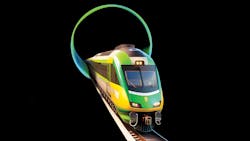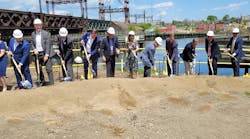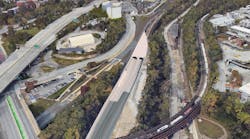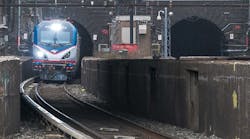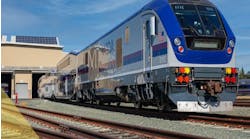According to ridership data collected by the American Public Transportation Association (APTA), heavy rail, light rail and commuter rail accounted for 46 percent of all transit trips in 2022. While the percentage is in line with where it has been historically, the success story is the increase in ridership rail modes have experienced over the calendar year. The 2022 year-to-date change for heavy rail shows a 36.55 percent increase, light rail shows a 37.85 percent increase and commuter rail shows a 51.82 percent increase. Systems including San Francisco Municipal Transportation Agency, El Paso’s Sun Metro streetcar, Sound Transit’s Link light rail, Sonoma Marin Area Rail Transit, Massachusetts Bay Transportation Authority, Maryland Transit Administration, New Mexico Rail Runner Express and Virginia Railway Express all experienced year-to-date changes in 2022 that were more than 100 percent.
Passenger rail and transit service providers continue to progress key projects, with the goal of delivering better service to riders. Concerning the Northeast Corridor, several projects have marked significant milestones including the Gateway Development Commission, which finalized agreements between funding partners on the Hudson Yards Concrete Casing – Section 3 project that will allow the project to move into construction. The Hudson Yards Concrete Casing – Section 3 is a critical component of the Hudson Tunnel Project. Amtrak began early construction work on the B&P Tunnel Replacement Program, which includes replacing aging wood crossties with new concrete crossties, installing new rail and completing track drainage improvements. Construction on the Norwalk River Railroad (Walk) Bridge Replacement Project started in May 2023. The existing four-track swing Walk Bridge, which hosts 175 passenger and freight trains per day, will be replaced with a structure that has two independent, moveable spans that will improve the reliability of the bridge.
However, not all passenger rail projects experienced progress. The Southeastern Pennsylvania Transportation Authority (SEPTA) made the decision to stop work on its planned King of Prussia (KOP) Rail project to dedicate its financial resources toward critical infrastructure work rather than advance the expansion project. SEPTA leaders expressed disappointment but explained the authority’s capital budget has a lack of flexibility that would not allow further pursuit of the KOP Rail project. Metrolinx also saw further delay to the Eglinton Crosstown LRT project, which was supposed to be in operation in late 2022 but did not open with Metrolinx placing the blame at the feet of its contractor, Crosslinx Transit Solutions. Metrolinx has vowed to work the Crosslinx Transit Solutions to get the quality issues with the project corrected and the project tested and operational.
One agency working to reduce risk associated with delays and cancellations of large project is the Metropolitan Council, which created a new regional transit infrastructure division in April that will provide what the entity calls “a more consistent and robust approach to complicated and critical infrastructure projects.” The new regional transit infrastructure division will manage the development and construction of regional transit projects that are significant in size and complexity and have substantial financial impact, including light rail and bus rapid transit projects.
Accessibility and Fleet Replacement
The past year has seen the federal government award its first grants through two new rail programs created under the Infrastructure Investment and Jobs Act. In December 2022, the Federal Transit Administration (FTA) awarded $686 million in grants through the All Stations Accessibility Program (ASAP). The total funds awarded represent grants meant for Fiscal Year (FY) 2022 and FY 2023, with FTA explaining it awarded funding for both years based on the significant number of funding requests received.
In the U.S., National Transit Database data from 2021 shows non-ADA accessible rail transit stations account for about 26 percent of all stations. Legacy rail systems have a higher rate of non-ADA accessible stations, with nearly 49 percent of rail stations on networks in New York, New Jersey, Chicago, Philadelphia, Pittsburgh and Boston non-ADA accessible.
The grants awarded through the ASAP Program will support station upgrades in many of these regions that have higher percentages of non-ADA compliant stations. Metropolitan Transportation Authority plans to use its $252.5 million grant to make the Myrtle Avenue, Norwood Avenue and Avenue I subway stations in Brooklyn and the Burnside Avenue subway station in the Bronx fully ADA accessible. Chicago Transit Authority will modernize its Irving Park, Belmont and Pulaski stations with elevators, ramp upgrades, improved station signage and other station enhancements with support of its $118.5 million grant.
In early May, FTA awarded $703.1 million to six transit agencies in California, Florida, Illinois, Missouri, Ohio and Utah to replace aging rail cars through the Rail Vehicle Replacement Program.
The Bureau of Transportation Statistics shows the average age of a commuter rail passenger coach was 25.3 years in 2021, which is a 25 percent increase compared to 2016. The average age of heavy-rail passenger cars was 23.9 years, which is a five percent increase compared to 2016, and the average age of light-rail vehicles was 19.5 years, which is an eight percent increase compared to 2016.
"One-third of our nation’s subway and commuter rail vehicles are more than 25 years old," said FTA Administrator Nuria Fernandez. "This program focuses on transit agencies that lack the funding they need to address overdue railcar replacements. We are proud to select these projects to improve passenger rail service for riders across the nation."
Outside of federal investment, rail transit service providers are working to improve rail service by increasing the number of active rail cars. In March, Port Authority of New York and New Jersey began operation of nine-car trains on the PATH Newark-World Trade Center Line as part of the $1 billion PATH Improvements Plan, which is a series of improvements designed to reduce delays and enhance customer experience. While the debut of nine-car trains is the first in PATH’s 100-year history, more trains of the same length will be rolled out gradually throughout 2023.
In the District of Columbia, Washington Metropolitan Area Transit Authority (WMATA) received approval to enter the final phase of its Return to Service Plan for its fleet of 7000 series railcars. With ridership growing throughout WMATA’s Metrorail system, the addition of more 7000 cars returning to service will support efforts to increase frequency.

Mischa Wanek-Libman | Group Editorial Director
Mischa Wanek-Libman is director of communications with Transdev North America. She has more than 20 years of experience working in the transportation industry covering construction projects, engineering challenges, transit and rail operations and best practices.
Wanek-Libman has held top editorial positions at freight rail and public transportation business-to-business publications including as editor-in-chief and editorial director of Mass Transit from 2018-2024. She has been recognized for editorial excellence through her individual work, as well as for collaborative content.
She is an active member of the American Public Transportation Association's Marketing and Communications Committee and served 14 years as a Board Observer on the National Railroad Construction and Maintenance Association (NRC) Board of Directors.
She is a graduate of Drake University in Des Moines, Iowa, where she earned a Bachelor of Arts degree in Journalism and Mass Communication.
